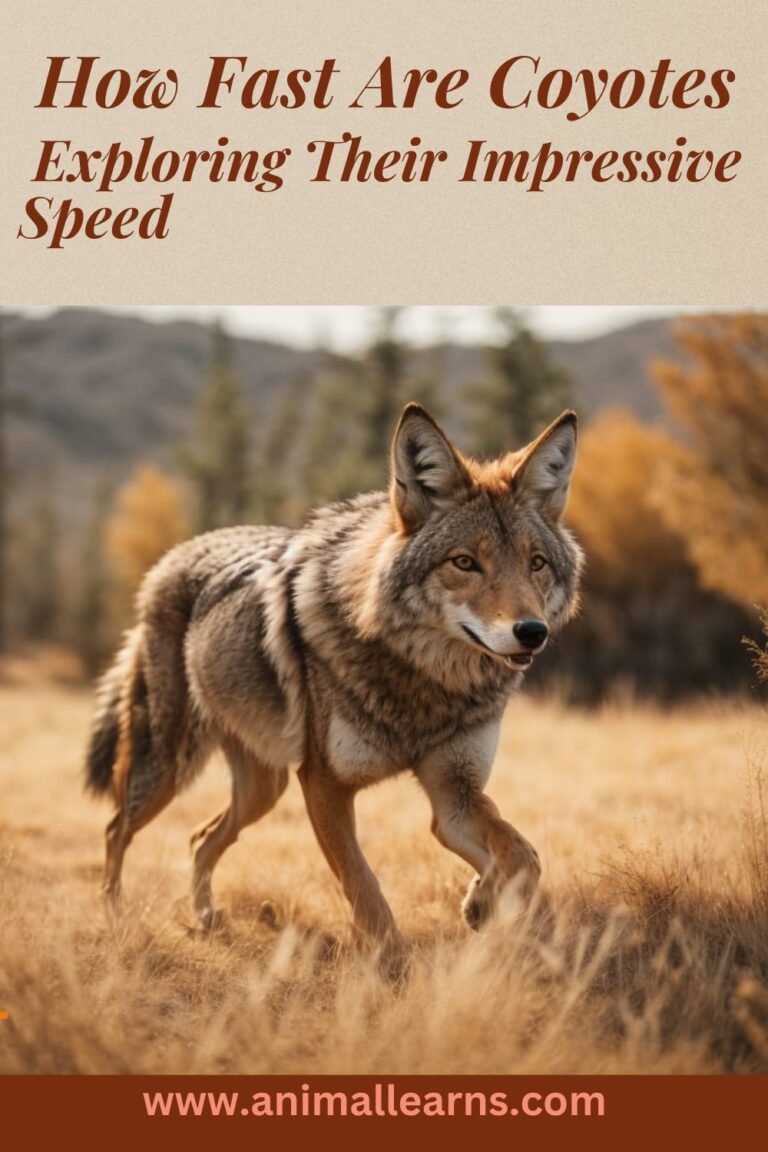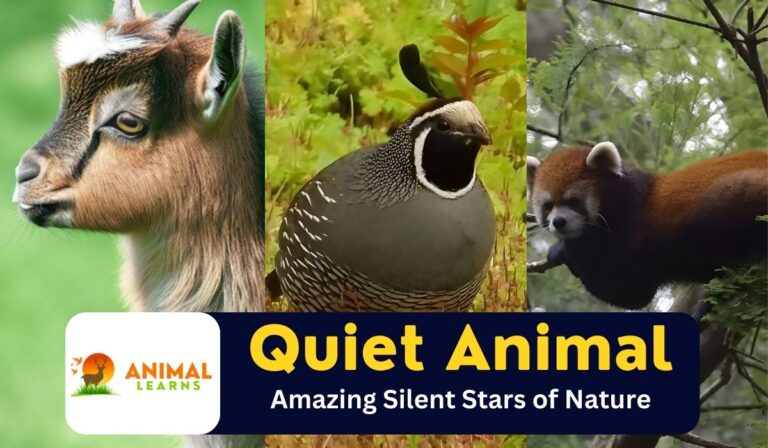Bandicoots: Types, and Interesting Facts
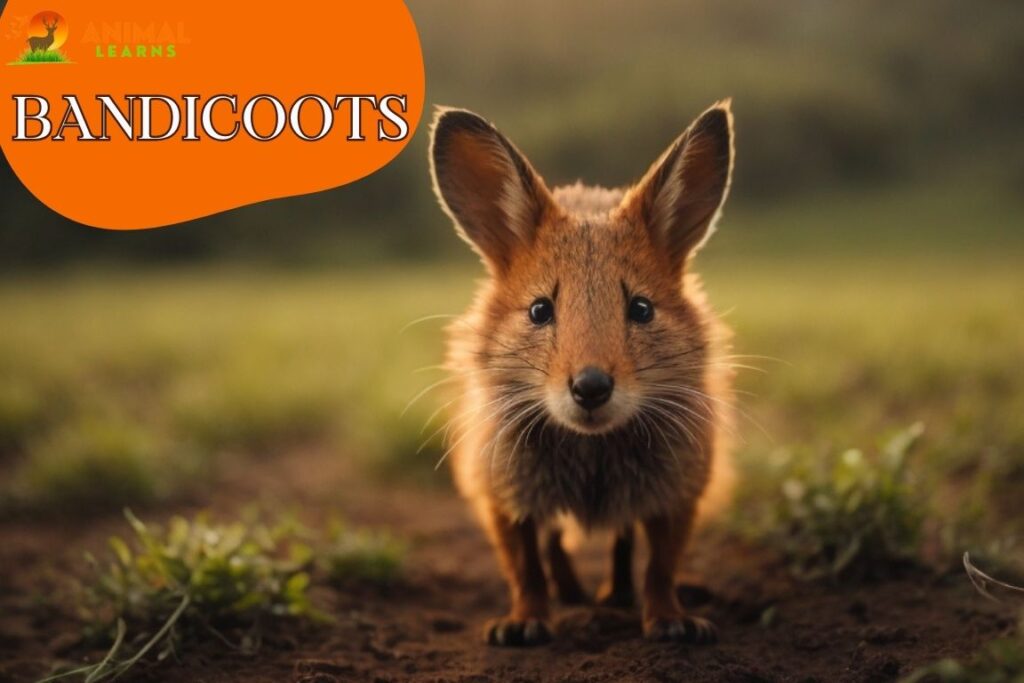
Bandicoots are unique Australian marsupials often compared to rodents. They play vital roles in their ecosystems. This marsupial is part of the order Peramelemorphia and is 30 to 80 cm long, with a tapered muzzle and distinctive syndactyl toes.
Foraging for insects and larvae, bandicoots leave behind ‘snout pokes,’ which are known for their snout pokes. The name bandicoot itself comes from the Telugu phrase ‘pandi-kokku,’ which means pig-rat in English.
Two bandicoot species are being conserved on reserves in Australia, while others, including the Golden Bandicoot and Eastern Barred Bandicoot, are protected through partnerships. Conservationists and wildlife enthusiasts continue to be captivated by these enigmatic creatures.
Appearance of Bandicoots
Contents

An animal that has a truly fascinating appearance, the Bandicoot is endemic to the Australian region. It has a unique blend of features that make it seem as though it were the result of a laboratory experiment.
A confluence of rodents, rabbits, and opossums, these animals have stout bodies, tapered muzzles, and distinct syndactyl toes. However, the bandicoot stands apart from other mammals due to its unique array of characteristics.
Diet
In order to fully understand bandicoots, one must look at their dietary habits. Bandicoots are excellent foragers, primarily hunting for insects and larvae underground. Their distinctive calling card – the ‘snout pokes’ – is left behind as they dig into the earth for food.
It is not only an essential part of their survival that makes them endearing to study, but also an endearing trait that fascinates those who study them.
Bandicoots Characteristics
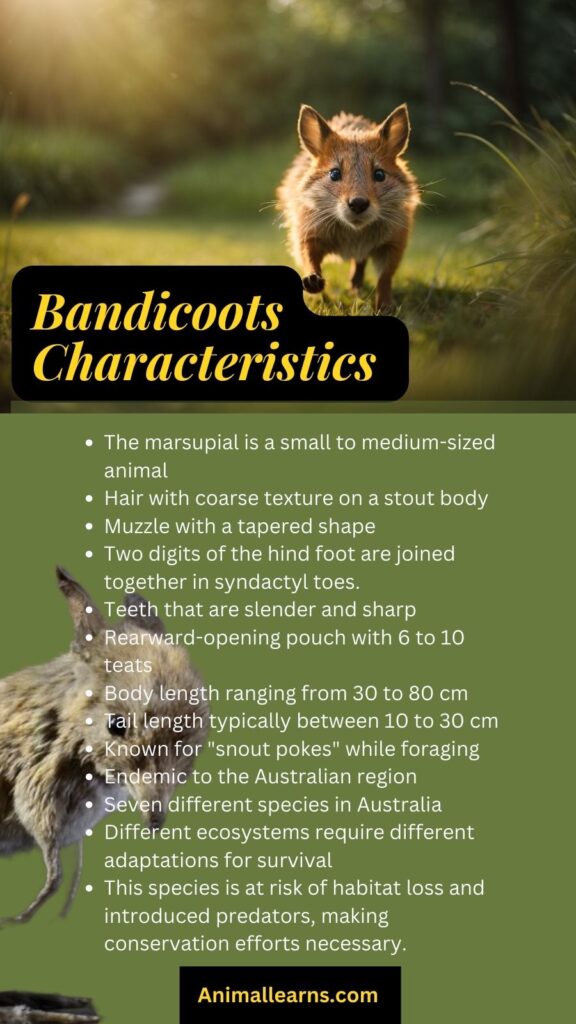
- The marsupial is a small to medium-sized animal
- Hair with coarse texture on a stout body
- Muzzle with a tapered shape
- Two digits of the hindfoot are joined together in syndactyl toes.
- Teeth that are slender and sharp
- Rearward-opening pouch with 6 to 10 teats
- Body length ranging from 30 to 80 cm
- Tail length is typically between 10 to 30 cm
- Known for “snout pokes” while foraging
- Endemic to the Australian region
- Seven different species in Australia
- Different ecosystems require different adaptations for survival
- This species is at risk of habitat loss and introduced predators, making conservation efforts necessary.
Habitat
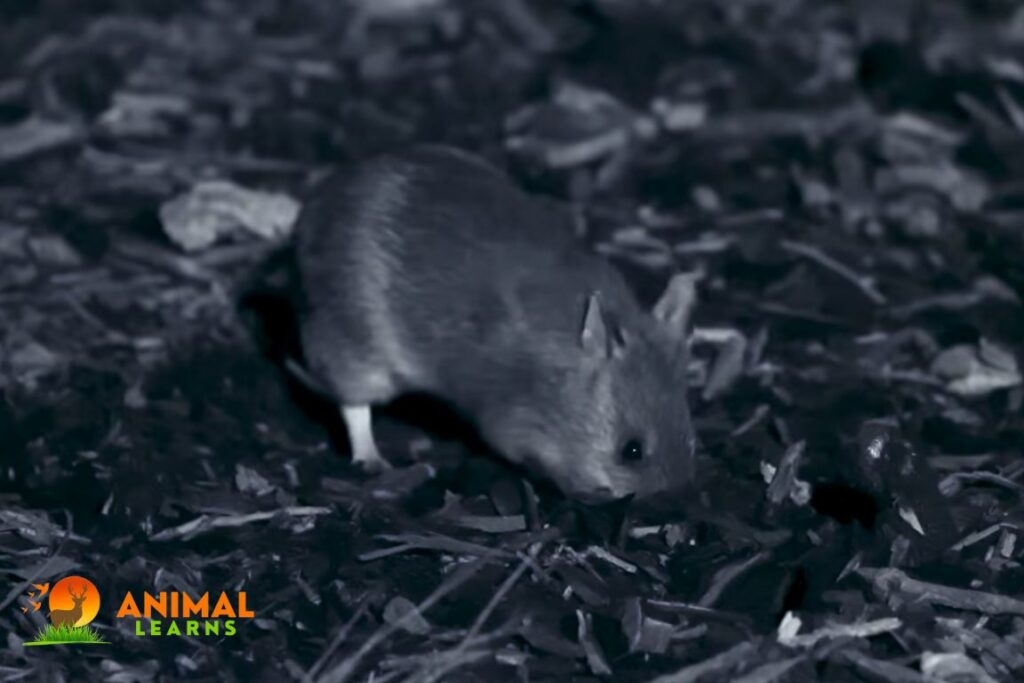
There are seven species of bandicoots that inhabit this continent, demonstrating a combination of adaptability and resilience. Their habitat and distribution are closely linked to its vast Australian landscape.
Since habitat loss and introduced predators pose a threat to these marsupials, conservation efforts are crucial. In order to preserve them, it is vital to understand their ecological niches, which are as diverse as their appearances.
Types
Several distinct species of bandicoot exist, each with its own unique characteristics and adaptations. Bandicoots include the following types:
- Bilby (Macrotis lagotis): As one of the most famous bandicoot species, the bilby, also called the greater bilby, is known for its rabbit-like appearance, long ears, and distinctively long snout. The burrowing habits of bilbies make them primarily nocturnal.
- Eastern Barred Bandicoot (Perameles gunnii): A striking black and white striped fur distinguishes the Eastern Barred Bandicoot (Perameles gunnii) from its native southeastern Australian habitat. Due to habitat loss and introduced predators, these animals have faced significant conservation challenges. They are predominantly herbivorous.
- Western Barred Bandicoot (Perameles bougainville): In the southwestern portions of Australia, the Western Barred Bandicoot is characterized by its striking stripes and inhabits the same habitat as its eastern barred cousin. Both species are primarily insectivorous with a declining population.
- Long-Nosed Bandicoot (Perameles spp.) Various regions of Australia host the Long-Nosed Bandicoot (Perameles spp.). Long-nosed bandicoots have long, elongated snouts that allow them to dig deeply into the forest floor for insects, small vertebrates, and plant matter.
- Northern Brown Bandicoot (Isoodon macrourus): It has a distinctive short, pointed snout and brownish-gray fur color. It is found in woodlands, grasslands, and wetlands in northern Australia.
- Western Desert Bandicoot (Perameles Bougainville desert): A subspecies of the western barred bandicoot is called the western desert bandicoot (Perameles Bougainville desert), which is adapted to arid environments, feeding on insects and plants.
- Golden Bandicoot (Isoodon auratus): As its name suggests, this omnivorous animal eats both small animals and plants in northern and central Australia.
Interesting Facts About Bandicoots
- Bandicoots belong to a unique branch of the marsupial family tree with a lineage dating back millions of
- Insects, worms, and various invertebrates are the primary foods of these small marsupials.
- Bandicoots dig burrows to seek food and shelter, using their strong front limbs.
- The bandicoot prefers to live a solitary life, only joining groups for mating.
- In order to avoid predators and extreme temperatures during the day, most bandicoot species are active at night.
- A pouch on the back of a female bandicoot prevents dirt from entering during digging.
- A high reproductive rate and several litters per year enable bandicoots to adapt to changing conditions due to their rapid reproductive rate.
- When bonding or disputing territories, bandicoots use vocalizations to communicate, including clicks and grunts.
- The remarkable biodiversity of Australia is exemplified by its diverse species of bandicoots, each adapted to a different habitat.
Predators and Prey
A bilby is an omnivore. They not only consume seeds, bulbs, and fruits of native grasses, but also insects, worms, small mammals, and lizards and frogs.
Several bilbies are killed each year by native predators, including wedge-tailed eagles (Aquila audax), carpet pythons (Morelia spilota), and monitor lizards (family Varanidae). The majority of bilby mortality is caused by invasive species, including red foxes, feral cats, and dingoes.
Conservation Status
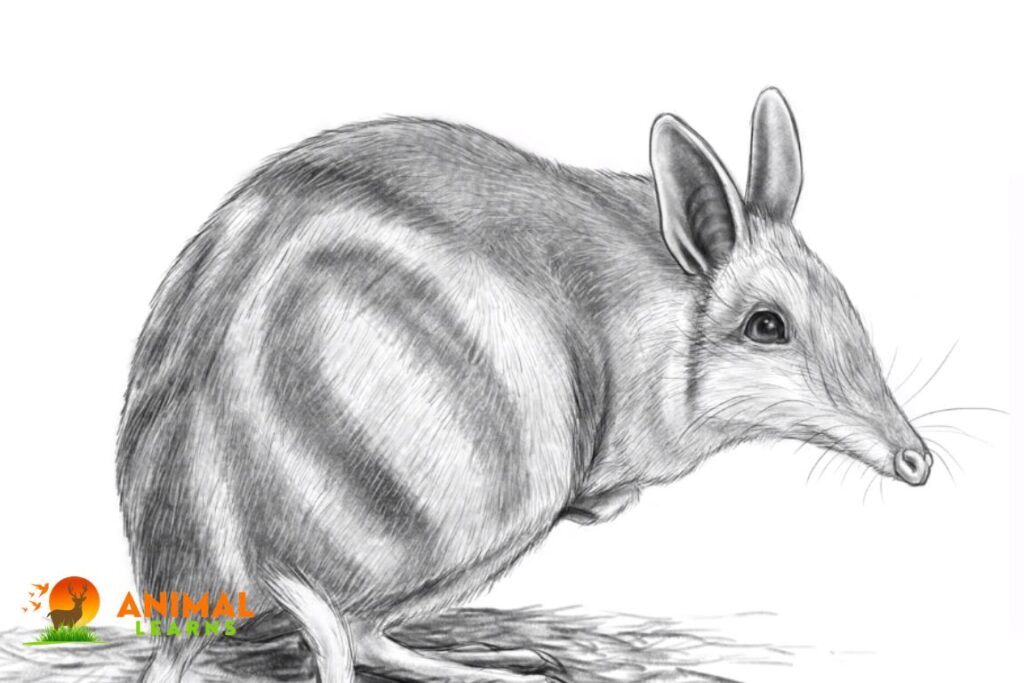
Bilby populations have declined because of habitat loss and predation caused by invasive species since the 1800s. It was also during these forces that the only other Macrotis species known—M. leucura, commonly known as the lesser bilby—went extinct between 1931 and 1960.
On the Red List of Threatened Species, the International Union for Conservation of Nature (IUCN) classifies the bilby as endangered between 1982 and 1994. The IUCN has upgraded the status of the animal to vulnerable since 1994.
It is believed that there are fewer than 10,000 bilbies left in the wild, despite reintroduction programs that have been established to create sustainable bilby populations in other parts of Australia, such as New South Wales, Southern Australia, Western Australia, and Queensland.
As an agricultural pest in Australia, European rabbits (Oryctolagus cuniculus) and bilbies compete for food. A campaign started in 1991 to replace the Easter bunny in Australia with the “Easter bilby” was launched by the Foundation for Rabbit-Free Australia Inc. to raise public awareness of the conservation of bilbies and to inform Australians of the ecological damage caused by introduced rabbits.
Mating
In Australia and nearby regions, bandicoots are small marsupials that exhibit fascinating mating behaviors. Females and males alike have multiple mating partners during a single breeding season due to their promiscuous mating habits.
Female bandicoots often have an established pouch for carrying their young until they are ready to emerge and fend for themselves. This approach to reproduction ensures genetic diversity in the species. It is a solitary animal, and bandicoots have short and efficient mating encounters as they are solitary.
Diseases
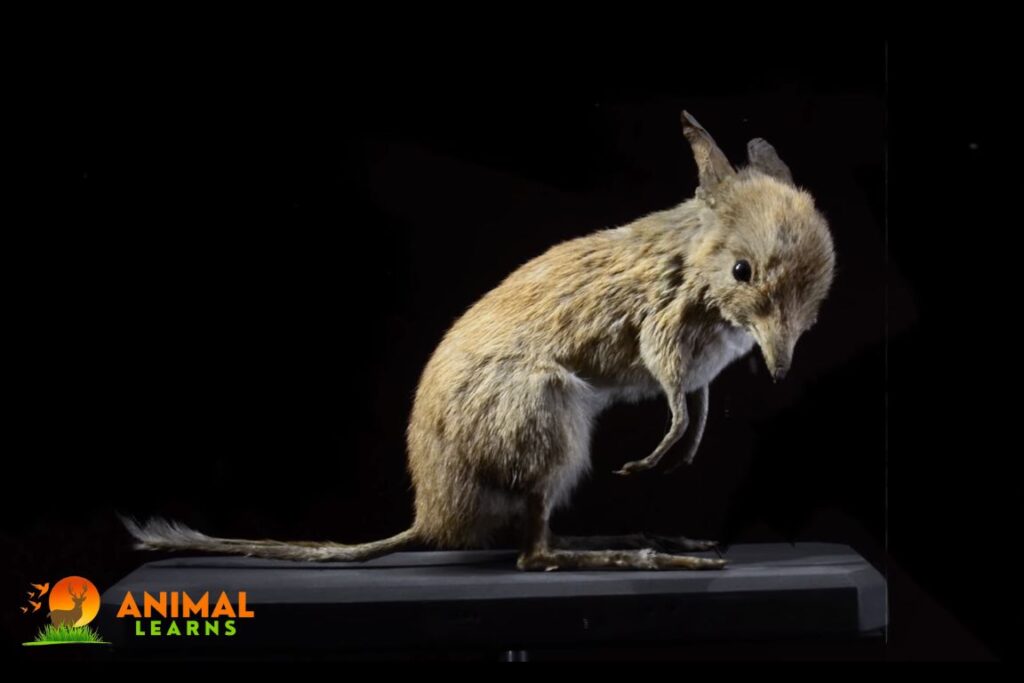
Since bandicoots are native to Australia and neighboring regions, they are affected by several health issues, some of which have significant consequences for their populations.
In addition to rabbit control, bandicoots may also be affected by a viral disease known as myxomatosis, which can cause severe illness and death. These small marsupials are constantly threatened by fleas and mosquitoes that transmit the disease.
Additionally, parasites, such as nematodes, can affect bandicoots’ digestive and respiratory systems, leading to reduced fitness and reproductive success.
Further, bandicoots are susceptible to diseases carried by introduced predators such as feral cats and red foxes, which often harbor various pathogens that can infect them. In areas where these invasive species are abundant, these diseases can adversely affect bandicoot populations.
FAQs
Are bandicoots animals that are active at night?
Yes, it is true that many species of bandicoots are known to be active, during the nighttime.
What is the diet of bandicoots, like?
Bandicoots have a diet that includes insects, small invertebrates, plants, and fungi.
How do bandicoots reproduce?
The female bandicoots nurture their ones called joeys in their pouches since they belong to the marsupial family.
How does a bandicoot differ from a bilby?
A bilby is another species that can be distinguished by its ears and unique appearance. It is primarily found in regions. Although both are marsupials bilbies are larger. Have ears compared to bandicoots.
Is it possible to keep bandicoots as pets?
Keeping bandicoots as pets is not advisable or legal since they are wildlife creatures and require care that cannot be provided in a setting.








